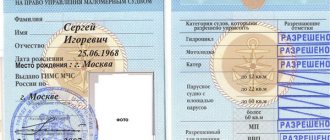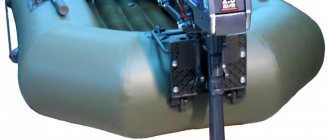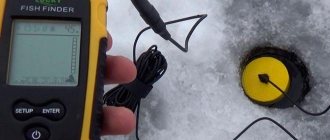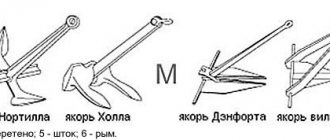Do you dream of a beautiful, spacious and reliable boat? So that you can feel the speed without traffic jams, feel the freedom of movement and hear the call of nature. Or maybe you need a small inflatable rowing boat for relaxing fishing and hunting? The desire to conquer expanses of water to the roar of a powerful engine, catch a headwind, confidently glide along the river surface, anticipating a large prey on a hook, can quickly disappear when meeting with a representative of the GIMS inspector of the Ministry of Emergency Situations.
The Club of Serious Fishermen FisherInfo.ru will tell you why a boat is needed to be registered with the State Inspectorate for Motor Vehicles, what taxes are expected by owners of water vehicles, and what fines the owners of water-powered vessels face for failure to comply with the laws.
Boats that need to be registered
In June 2021, regulations for the operation of small vessels were introduced. They were created to alleviate the plight of ordinary fishermen and boaters. Especially for the contingent of water motorists who do not consider buying a boat as a means of transportation around sea and ocean harbors for the purpose of commercial transportation of passengers and other activities actively using river routes, the bureaucracy with paperwork was simplified. According to the new rules, most of the fishermen, instead of paperwork in the inspection offices, will finally take up their favorite brainchild - fishing. And questions about whether an inflatable rubber or PVC boat needs to be registered will fade into oblivion.
GIMS – State Inspectorate for Small Vessels of the Ministry of Emergency Situations of Russia
Boats that need to be registered with GIMS:
- used for movement in areas closed to normal use or near state borders;
- length from 20 meters or more;
- with a permitted number of passengers of 13 or more;
- with a weight heavier than 200 kilograms;
- with a power plant with a declared maximum power of more than 8 kW or 9.9 horsepower;
- with a power unit with a power of up to 10 horsepower, but the installation of engines above 9.9 l/s is permitted.
Important! Any surface floating transport that can be equipped with an engine with a power of more than 8 kW or more than 10 horsepower is subject to mandatory registration with the GIMS.
Boats that do not need to be registered
Owners of inflatable PVC boats are worried whether they need to contact the state inspectorate and pay transport tax. After all, a small inflatable or rowing boat on the water seems like such an insignificant means of transportation.
Vessels that do not need to be registered with the State Inspectorate:
- boats purchased for the purpose of traveling in inland waters (rivers and lakes) of the Russian Federation;
- a watercraft without a power plant and a cargo capacity of up to 200 kg inclusive;
- a watercraft with a power plant power of up to 8 kW or 9.9 l/s;
- rowing boats.
Registration of a rubber boat
For fishing, hunting and various utility work, an inflatable rubber boat is simply necessary. The law of the Russian Federation obliges the registration of catamarans, jet skis, yachts, boats and various inflatable boats that fall under the regulations of the State Inspectorate for Medical Information.
A rubber boat must be registered if:
- weight more than 200 kg;
- the installed engine has a power of more than 8 kW or 9.9 l/s;
- The boat's registration certificate allows the installation of a motor with a parameter exceeding 10 l/s.
All rubber boats that do not fall within these parameters do not need to be registered with the State Property Management System. But the rules for using rubber boats should not be violated. On the water, an employee of the Ministry of Emergency Situations of the Russian Federation may demand from the shipowner a document authorizing the right to operate the boat.
When going out on the water, the owner of rubber boats must have:
- Russian passport or a copy thereof;
- document of ownership of the vessel;
- driving license (for boats with engine power above 5 hp/3.58 kW);
- oars;
- life vest;
- scoop.
Small boats that do not require registration
New amendments to the regulations for obtaining a document permitting the use of watercraft on all types of water bodies exclude the registration procedure for the following types of boats:
- non-motorized boats, the length of which does not exceed 20 m;
- non-motorized vessels that weigh less than 200 kg, including equipment;
- non-motorized watercraft, the number of passenger seats in which does not exceed 12;
All of the above watercraft are equipped with an engine whose power is less than 10.88 horsepower.
Delivery for registration
In order to register any boat that meets the parameters of the requirements with the State Inspectorate of Small Boats, namely to obtain a Ship's Ticket for a small boat, you must:
- Buy a boat.
- Collect the required list of documents.
- Come to GIMS, located at the place of registration.
- Provide the required list of documents.
- Get a Ship's Ticket.
IMPORTANT! You can register a boat with GIMS without leaving your home through the State Services portal.
Required list of documents to be submitted to GIMS:
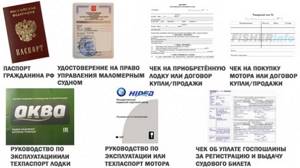
Sample ship ticket:
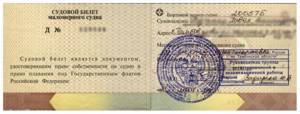
Required documents
The process of registering a small vessel by an individual and a legal entity differs from each other.
To register a watercraft, a private owner must provide:
1. Application for registration of the vessel. The form can be filled out on the official website of GIMS. 2. A document that identifies the applicant. Typically, a passport is used here. 3. Power of attorney. It is provided if a person cannot independently visit the regulatory authority or plans to provide the use of the vessel to another person. 4. Property documents. Inspectorate employees must prove that the registered vessel belongs to the applicant. This can be done by providing a ship's ticket or a purchase and sale agreement. 5. A document by which GIMS can issue a vessel permission to sail in a certain type of water area. This may be a ship's ticket or another document that indicates the performance and technical characteristics of the craft. 6. If the vessel was previously under the control of the water register of another state, you will need to provide an extract stating that it was excluded from there. If this is not done, registration in the Russian GIMS is not possible. 7. A document confirming the applicant’s Russian citizenship. This could be a passport or registration certificate.
In the application, the person must indicate which regulations he refers to when deciding to register his vessel.
If a person does not have documents that can confirm permission to sail in a certain water area, it is possible to obtain them when registering a watercraft with the GIMS. To do this, you will need to write a separate application. The service does not incur material costs.
Read: How to choose the right boat for fishing
GIMS employees have the right to demand additional documents from a person at their discretion.
Wanting to speed up the process of registering a PVC boat, a person can submit the following documents:
- a receipt for payment of the state fee for registering a small vessel;
- a document confirming the absence of tax arrears;
- if the ship was brought from abroad, you can provide a declaration or an extract from it that confirms this fact;
- a conclusion that the small vessel has been inspected by other regulatory authorities.
Numbers
The documents are in order, the ID is in my pocket and the ship's ticket has been received. There is one more important step left to confidently and freely disperse the waves on the territory of the Russian Federation - this is to put a number on the boat in accordance with the rules of GOST and GIMS.
A correctly applied number must have the following characteristics:
- comply with recommended sizes;
- have a contrasting color with the boat;
- be between the bow and a quarter of the length of the ship's stem.
Correct numbering

Instructions for applying a number on a board made of vinyl film or with a laminated coating:
- Degrease the side surface of the boat where the number will be written (the starboard side is the flag at the bow of the boat, the left side is the flag at the middle of the vessel).
- Measure the overall length of the boat.
- A quarter of the length from the stem will be the middle of the license plate.
- Measure equal distances (875 mm according to GOST) from this middle to the right and left to determine the boundaries of the license plate.
- Together with the flag, the number must occupy 1750 mm according to the state standard.
- Apply soapy water to the side housing.
- Separate the flag image from the paper base and attach it to the soap body.
- Measure 50 mm and glue the second letter of the region.
- Add the remaining number designations as well.
- Adjust and align characters.
- Smooth out and squeeze out any remaining air bubbles from under the film.
- Leave the work to dry for 24 hours.
Registration procedure
If a person realizes that his rubber boat needs to be registered with GIMS, he must act according to the following algorithm:
1. Prepare an application for state certification of a small vessel. This can be done either directly in the GIMS office or electronically on the State Services portal. 2. Submit documents to the regional office of the registration authority. 3. Wait until the department employees accept and register the documents. 4. Wait until GIMS employees check the correctness of filling out the documents and make copies of them. According to current legislation, the procedure should not take more than half an hour. 5. Employees of the registration authority have the right to verify the veracity of the information provided by a person using various resources. 6. If no violations are identified during the execution of documents, the inspectors set a time to inspect the vessel. 7. After the technical examination, GIMS employees must notify the applicant within three working days of a decision to approve or refuse his request to register a small vessel. 8. If the decision is positive, the person will be reissued a ship ticket, if necessary. 9. The watercraft is assigned an identification number. At the request of the owner, in addition to the number, the name of the vessel can be entered in the ship's ticket.
The identification number includes 11 alphanumeric characters and the flag of the Russian Federation. It is applied on both sides of the vessel in a visible place. The dimensions and location of symbols are specified in special documentation.
Read: How to choose the right fishing waders
After the introduction of amendments to the current legislation, the format of the ship's ticket has changed. If previously it was a booklet convenient for storage and transportation, now a ship’s ticket is an A4 paper sheet filled out on both sides. To ensure greater safety of the original, you are allowed to take a certified copy of the document with you when sailing.
Rights
Do you need a license for a boat with a motor when the sailing area is a local pond or a small river in the countryside?
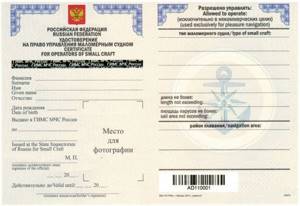
New sample gims certificate
GIMS employees do not care for what purpose a person purchased a watercraft: fishing, hunting or decorating a coastal pier. A boat, a yacht, a catamaran, a boat, a bath basin or a bathtub - everything that fits the GIMS parameters must comply with the established rules.
Important! A license for a vessel with a power of less than 5 horsepower is not required!
A license is required for water transport with the following parameters:
- A motor vessel with a power plant with a power of 5 horsepower or 3.58 kW.
- A boat is a motorized watercraft with a stationary engine.
- A motor boat is a motorized watercraft with an outboard motor(s).
- A jet ski is a frameless water model with a mechanical power plant.
- Sailing vessel.
The fine for driving a boat without a license in 2021 - 2021 ranges from 500 to 1000 rubles

Abbreviation of navigation areas printed on the certificate
How to get
To obtain a certificate from GIMS, you must provide the following list of documents:

To hold a license allowing you to operate a boat with a motor with a power greater than 10 horsepower, you must:
- Take a 1.5 month navigation course at GIMS or a commercial center.
- Successfully pass the theoretical and practical exam at GIMS.
- Provide a medical certificate confirming your fitness to operate a small boat.
- Wait 10 days to obtain a boatmaster's license.
- Obtain a motor boat license (certificate) with a validity period of 10 years, specified by the type of vessel and the territory of permitted movement.
Tax
The owner of a watercraft equipped with a power plant with a power of more than 10 l/s must pay transport tax to the treasury of the Russian Federation.
Important! Transport tax on small vessels is a regional tax, which is calculated in each constituent entity of the Russian Federation at the tax rate per horsepower in rubles.
Regions of the Russian Federation determine the transport tax on small vessels based on two rates for a power plant with the following power:
- up to 100 l/s;
- more than 100 l/s.
Several regions of the Russian Federation calculate fuel costs at their own rate, which has different categories for dividing horsepower. And accordingly, there is a different threshold for the amount required to pay tax.
What you need to know about the tax on a motor boat in the Russian Federation:
- the tax payer is the citizen in whose name the watercraft is registered;
- the tax rate is calculated in the region where the citizen who owns the watercraft is registered;
- Transport tax must be paid before December 1 of the current year.

